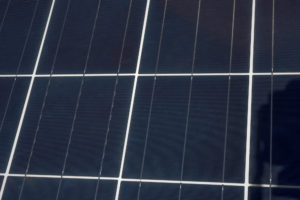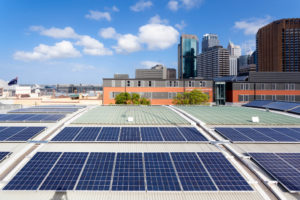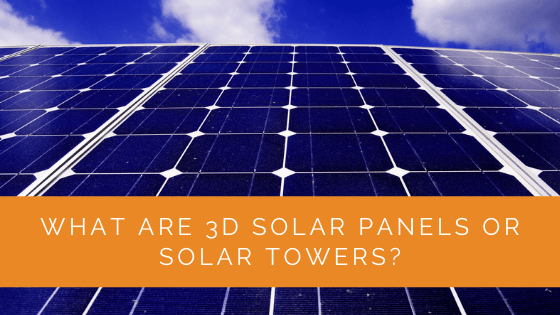Solar energy is a gift that keeps on giving. We can power our homes, offices, and other spaces all day with the help of the solar energy received.
Solar panels convert this solar energy into electricity, which is a more usable form of energy. These panels have photovoltaic cells on their surface, and they absorb the photons present in the sunrays to use as electricity.
These flat panels often take a lot of space and are still unable to provide enough electricity. With urban housing becoming more clustered with each passing day, people are no longer left with the option to install rows and rows of solar panels in their homes.
3D solar panels are a space-efficient solution to this issue. They can maximize the production of solar energy while taking up little to no space! Continue reading to learn more about solar towers or 3D solar panels.
Contents
- 1 Key Takeaways
- 2 What Are 3D Solar Panels Or Solar Towers?
- 3 How Do Solar Towers Work?
- 4 What Are The Benefits Of A Solar Tower?
- 5 Where Can These Structures Be Used?
- 6 Case Study: Implementing 3D Solar Panels in Urban Environments
- 7 Expert Insights From Our Solar Panel Installers About 3D Solar Panels
- 8 Experience Solar Excellence with Us!
- 9 To Conclude With
Key Takeaways
- 3D solar panels or towers are a space-efficient solution for generating more electricity using solar energy. They maximize energy production without taking up much space, making them ideal for urban areas with limited room for traditional solar panels.
- These stacked panels can absorb up to 20 times more sunlight compared to flat panels, significantly increasing energy production. A solar tower produces 20 times more electricity than a flat panel due to its 3D design.
- 3D solar panels provide a predictable amount of energy year-round and are becoming more accessible for homes, offices, and public spaces. They offer a promising solution for widespread adoption of clean energy in the future.
What Are 3D Solar Panels Or Solar Towers?
3D solar panels or towers are a space-efficient solution to generating more electricity using solar energy. Most urban spaces do not have the luxury of installing traditional solar panels in long and wide rows. However, if there is a certain amount of electricity you wish to generate, you will need a specific number of solar panels covering a set surface area.
With 3D solar panels, you can tackle this issue with absolutely no trouble. This is because the solar panels are strategically stacked on top of each other in such models. These panels end up forming a tower-like structure that significantly increases the surface area of the panels.
The more the surface area, the more will be the light absorption by the photovoltaic cells. This will help you generate as much electricity as you want without using up too much of your free space.
According to studies conducted at MIT, you can increase the amount of sunlight absorbed by solar panels by approximately 20 times when you use a solar tower structure.
These solar panels are stacked to form either cubes or towers. It is different from the 2D planer diode structure of traditional solar panels.

How Do Solar Towers Work?
While these designs sound excellent in theory, some work still needs to be put into the research and development of these panels. 3D solar panels are PV panels stacked on top of each other to reduce the space used and improve energy production.
These panels are installed to absorb a lot more sunlight when the sun is on the horizon. These PV cells are specially developed to make sure that they can absorb more sunlight efficiently.
Since PV cells absorb photons, these stacked panels give them a lot more room to bounce around. The set-up maximizes the number of photons absorbed, ultimately increasing the electricity production of the entire solar panel set-up.
What Are The Benefits Of A Solar Tower?
3D solar panels are not a common sight to be seen today. However, with consistent research and development, many benefits of using this type of panel set-up have been discovered. Here’s how using a 3D solar panel or solar tower could benefit us shortly!
1. They Save Space
By stacking up solar panels one on top of the other, we will be saving a ton of space.
Urban cities already feel too claustrophobic. So, people who wish to be energy-efficient cannot follow through with their plans of implementing solar energy in their homes.
A stackable solar panel set-up can increase their clean energy production while not giving up too much space. This makes it a perfect option for the near future, where people will be struggling for space.
2. They Increase Energy Production
A flat panel set-up is traditional, but it has worked for people for decades. However, energy demand is increasing by the day, and people with solar panels now have to rely on the grid to provide them with electricity.
Stacked solar panels significantly increase energy production while occupying the same amount of space as a single flat panel. A solar tower will produce 20 times more electricity compared to a flat solar panel. This could be credited to their 3D design!
3. They Will Provide a Predictable Amount of Energy
One of the biggest concerns with solar panels is the amount of energy you will receive. Electricity production by solar energy can be unreliable.
This is why most people always keep a grid connection handy to fulfill their energy requirements.
With stackable solar panels, you receive a predictable amount of energy due to the uniformity in production. Researchers are constantly looking for ways to make this technology better than traditional solar panels to be used readily.
4. They Will Be Highly Accessible
Accessibility of solar panels is a huge concern when it comes to using clean energy in homes. Solar panels can be expensive for people, and some people live in compact apartments that do not have enough room for solar panels to be installed.
These stackable solar panels are going to be highly accessible for people everywhere. They will be used in private and public spaces so that people can utilize green energy.
Researchers at MIT are working on ways to cut the cost of production and installation so that everyone can use these solar panel set-ups. They are trying to develop a way to ship these panels flat to be installed remotely instead of shipping the whole tower itself, which is not feasible yet!

5. They Provide Equal Amounts of Energy All Year Round
One of the best features of these solar panels is that they provide consistent energy all year round. Flat panels depend on the amount of sunlight they receive, the angle of the sunrays, how cloudy it is, and even what the earth’s position is in orbit.
While some of these factors still influence the amount of energy generated, there is no change in the electricity production in the different seasons. This is because these panels are vertically installed in a 3D structure to capture sun rays better than 2D flat panels.
These solar panels can capture more sunlight when the sun is at the horizon, which is not generally the case with flat panels. The panels can bounce photons across this structure and absorb as much sunlight as they can.
Where Can These Structures Be Used?
Large-scale studies have been conducted on solar panels in everyday life in private and public sectors. This stackable solar panel can be installed in a large number of places. Here are a few examples of where you can find it soon!
- At homes: If you live in suburban homes, you can get these panels installed in your backyards without giving up too much space.
- In offices: Stacked solar towers can be installed next to office buildings to power them during the day.
- Public parking spaces: Installing solar towers next to parking spaces will provide electricity to recharge electric cars in the establishment.
Case Study: Implementing 3D Solar Panels in Urban Environments
Background
Solar Panels Network USA is committed to advancing solar technology to meet the increasing energy demands of urban environments. Recently, we explored the potential of 3D solar panels, also known as solar towers, to enhance energy production while conserving space in densely populated areas.
Project Overview
The project aimed to install 3D solar panels in a mixed-use urban complex to evaluate their efficiency and practicality. The primary goal was to demonstrate how these innovative panels could maximize energy output in limited spaces, making solar power more accessible to urban residents and businesses.
Implementation
- Site Assessment:
- Conducted a detailed site assessment to identify optimal locations for the installation of 3D solar panels.
- Selected a mixed-use complex with residential units, office spaces, and a public parking area.
- Installation:
- Installed 3D solar towers in the backyard of residential units, next to office buildings, and in the public parking area.
- Used modular and scalable designs to adapt to the specific spatial constraints of each location.
- Energy Monitoring:
- Implemented an energy monitoring system to track the performance of the 3D solar panels.
- Collected data on energy production, efficiency, and space utilization compared to traditional flat solar panels.
Results
The 3D solar panels demonstrated a remarkable increase in energy production, generating up to 20 times more electricity than traditional flat panels. The stacked design allowed for efficient use of limited space, making it feasible to install solar panels in urban environments without compromising on energy output.
Residential units reported a significant reduction in their reliance on grid electricity, while office spaces benefited from a consistent and reliable source of clean energy. The public parking area was able to provide sufficient power for electric vehicle charging stations, further promoting the use of sustainable energy.
The predictable energy output throughout the year, regardless of seasonal changes, was a standout feature, providing a stable and reliable energy source for all users.
Summary
The implementation of 3D solar panels in an urban mixed-use complex showcased their potential to revolutionize solar energy adoption in densely populated areas. By maximizing energy production and minimizing space usage, these innovative panels offer a promising solution for the growing energy needs of urban environments. Solar Panels Network USA continues to lead the way in developing and implementing cutting-edge solar technologies to promote sustainable energy solutions for the future.
Expert Insights From Our Solar Panel Installers About 3D Solar Panels
3D solar panels are revolutionizing the way we think about solar energy, especially in urban areas where space is limited. Their stacked design allows for significantly higher energy production without the need for extensive roof space.
Senior Solar Engineer
The ability of 3D solar towers to absorb up to 20 times more sunlight compared to traditional flat panels makes them a game-changer in the solar industry. This efficiency boost is essential for meeting the growing energy demands of both residential and commercial users.
Lead Solar Technician
One of the most promising aspects of 3D solar panels is their potential to provide a consistent energy output throughout the year. This predictability in energy production is crucial for both private and public sector applications, ensuring a reliable source of clean energy.
Chief Installation Engineer
Experience Solar Excellence with Us!
Trust in Solar Panels Network USA, where our seasoned experts deliver top-quality solar solutions for homes and businesses nationwide. With a legacy of countless successful installations and a commitment to sustainable energy, we’re your reliable partner in the solar journey. Ready for a brighter, eco-friendly future? Call us now at (855) 427-0058 and harness the power of the sun!
To Conclude With
3D solar panels are an excellent development for solar energy. This will make clean energy more accessible, and people will get used to using solar energy in their daily lives. We can only hope for this design to be ready for exponential commercial use in the near future.
They might require a little extra research, but the proficient team of developers at MIT is working tirelessly to make this a possibility. Until then, we can study this design more and come up with ways to implement it on our own!
About the Author
Solar Panels Network USA stands at the forefront of solar energy solutions, driven by a team of seasoned solar engineers and energy consultants. With over decades of experience in delivering high-quality solar installations and maintenance, we are committed to promoting sustainable energy through customer-centric, tailored solutions. Our articles reflect this commitment, crafted collaboratively by experts to provide accurate, up-to-date insights into solar technology, ensuring our readers are well-informed and empowered in their solar energy decisions.

